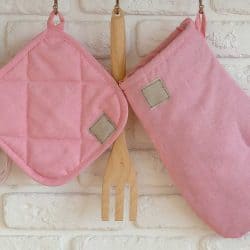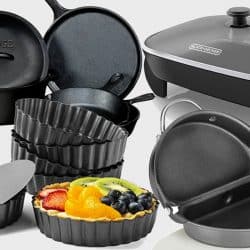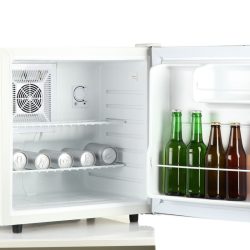Shopping for a potholder can seem like an easy task. However, the sheer amount of shapes and sizes there are can make things a bit complicated. Using properly sized items is especially important in the kitchen. An improperly sized potholder can unintentionally cause damage either by catching on fire or not allowing a proper grip on hot pans. To help you avoid these kitchen problems, we've done the research and can tell you what size your potholder should be.
Potholders generally measure between five inches by five inches and 10 inches by 10 inches. The most common potholder shape is a square, although this isn't the only shape available.
Now that you know how big a potholder should be, let's get more specific. Keep reading to discover common shapes of potholders, what happens if you use them wet, and how to make your own potholder.
![A mother taking out apple pie fresh from the kitchen oven, What Size Should A Pot Holder Be? [With Examples!]](https://kitchenseer.com/wp-content/uploads/2021/06/What-Size-Should-A-Pot-Holder-Be-667x1000.png)
Common potholder sizes
Being a protective device, potholders need to cover the hand without getting in the user's way. Potholders will come in a variety of shapes and sizes so they can work for more people. No matter your hand size or preference, there is a potholder for you. There are three different size categories for potholders: mini potholder, standard potholder, and large or oversized potholder.
Mini potholder
These potholders measure six inches by six inches. Potholders that have sides smaller than seven inches are referred to as fingertip potholders. This style of holder is specifically for protecting your fingertips. Instead of a normal shape, fingertip potholders are more clamp-like in appearance.
Check out this 4-set of mini potholders on Amazon.
Standard potholder
These are the most common potholders and measure between seven by seven inches and nine by nine inches. While most people can use a standard-sized potholder and be fine, some may find working with a mini or large potholder easier. If you have too much extra material, it can get in the way, either dropping too close to open flame or making it difficult to grip pots and pans. Having too little material is just as dangerous and can cause burns.
Check out this 7-inch potholder on Amazon.
Large or oversized potholder
Large potholders have one or more sides measuring at least 10 inches. Depending on the shape of your potholder, it's common for only one side to measure over 10 inches. The discrepancy in length can make the potholder easier to work with.
Check out this large 10-inch potholder on Amazon.
Common potholder shapes
Not only does the size of the potholder matter, but its shape does too. Comfort and practicality are very important. Some potholders are designed in a fun and interesting way. However, more elaborate shapes don't always mean the product works properly. It's important that the potholder can cover your hand, not just look interesting.
Potholders are most common in the shape of a square with rounded corners. This shaped potholder is the easiest to make, and there are many do-it-yourself tutorials on making one at home. While they are easy to make and common to find, you don't have to get your holder in a square shape.
Rectangles, ovals, and circles are also common potholder shapes. The standard size and mini potholders tend to have more style options. Not only do they come in those standard shapes, but you also have novelty designs like flowers or fruits. Large or oversized potholders are generally only seen in squares, circles, or rectangles.
Check out this 7x9-inch dog-shaped potholder on Amazon.
What is the purpose of a potholder?
Potholders are used to protect your hand when handling hot surfaces in the kitchen. They are designed to be used with one hand. To protect both hands, multiple potholders are needed. Standard and mini-size potholders are typically found in a set. Due to their size, large potholders are typically bought one at a time. In order to properly protect hands from heat, a potholder has to withstand at least 400 degrees Fahrenheit. Some potholders can withstand higher than 500 degrees Fahrenheit. This is due to the material it's made from.
These items have been used not only for personal protection but also as a symbol of cultural movements. Before the 19th century, scholars believe that hooks were used to transport hot objects. The first potholder was found in the mid 19th century. These potholders contained the phrase "Any Holder But A Slave Holder." They were also used in the internment camps during World War II. Potholders provide a way for people to protest unfair actions or otherwise show what the owner believes in.
Why not use a wet potholder?
Using a completely dry potholder, oven mitt, or towel is very important when handling hot objects. A wet potholder can cause serious burns called scald or steam burns.
What is the difference between a potholder and an oven mitt?
Both a potholder and an oven mitt are designed to protect your hand from hot objects in the kitchen. They are also made from the same kinds of materials. However, an oven mitt is designed to be worn. Potholders leave more of your body exposed to heat. When you wear an oven mitt, it protects the entirety of your hand as well as your forearm.
How do you make a simple potholder?
Homemade potholders can either be sewed, made from a loom, or crocheted.
Sewing
To make a potholder by sewing, you'll need fabric, cotton batting or additional layers of fabric, thermal batting, and thread and needle. Start by cutting all your materials to the size you want. Anywhere between five and 10 inches is acceptable; however, going larger is usually better. If you mess up, you have more fabric to correct mistakes.
Lay your fabric down with the designs facing the same way. Then, place your batting down and pin everything together, leaving an open space. Sew everything together, except for the opening. Once everything is sewn together, flip your creation, so the designs are facing out. Sew about a quarter-inch seam all the way around, and you're set.
Loom
You can make a loom potholder out of yarn, scraps of fabric, or even old clothing. This style is great for people who may already have a loom at home or even beginner crafters. Loom kits are available, which can make things much easier for a more inexperienced potholder maker.
Check out this potholder loom kit on Amazon.
Crochet
To crochet a potholder, you'll need a crochet hook and 100% cotton or other high-quality yarn. This is incredibly important because you don't want your potholder to melt or burn. From there, it's as easy, or as hard, as you want it to be. Crochet squares can be as easy as creating a chain of yarn to your desired length. Then, you double or single crochet each row until you, again, reach your desired length.
How do I make my potholder heat resistant?
When you are quilting your homemade potholder, there are a few options to make it heat-resistant. You can either use a special heat-insulated batting, use a few extra layers of fabric, or use an extra layer of 100% natural cotton batting.
If you're making a loom or crochet potholder and use cotton or wool yarn, then you won't need to do anything to make your potholder heat-resistant. These materials already have a natural resistance to heat.
Check out this 100% natural cotton batting on Amazon.
In Closing
Whether you decide to make or purchase your potholder, it's important that they are the proper size and shape. Standard potholders typically work well for everyone and have sides that measure between seven and nine inches. Squares are the most common shape amongst all the sizes of potholders. However, you can also find or make more interesting shapes. Whatever size you end up with, make sure that it's large enough to protect your hand from the high heat of the kitchen.
You may also like the following:
Do Ramekins Come In Different Sizes?
What Sizes Do Casserole Dishes Come In?







![Kitchen glove, potholder, oven protection are hanging over white brick wall, 12 Types of Pot Holders [And How To Choose]](https://kitchenseer.com/wp-content/uploads/2021/06/Kitchen-glove-potholder-oven-protection-are-hanging-over-white-brick-wall-250x250.jpg)


![Kitchen utensils in containers on table, Kitchen Utensils: The Ultimate List [Do You Know All 56?]](https://kitchenseer.com/wp-content/uploads/2020/05/Kitchen-utensils-in-containers-on-table-250x250.jpg)

